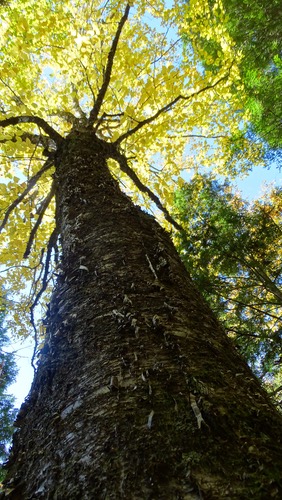The Old Forest policy does not adequately protect Old Forest
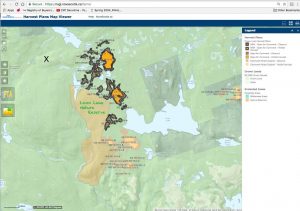
NSDNR is responding to concerns expressed by Danny George about ongoing harvests near Loon Lake Nature Reserve, but they are NOT amongst the approved harvests currently posted on the Harvest Plan Map Viewer – X is the “Danny George site”.
This is a lengthy post, so I am providing a clickable Table of Contents.
In this post:
The location of the “Danny George Site”
DNR on Old Growth and the Old Forest Policy
Some comments on DNR’s perspectives
An independent investigation is called for
Seeking shelter in Old Forest Policy
Background
This story – at least the most recent episode – was kicked off by forester Danny George as described in a front page article by Aaron Berwick in the Chronicle Herald, with a video available in the online version (view Danny George rings the alarm bell (again) on Loon Lake Nova Scotia clearcuts of Old Growth, Post Feb 23, 2018); and in an interview conducted in the field with Danny George by CBC’s Phlis McGregor, aired on CBC’s Information Morning On Monday Feb 26. (I have posted an abbreviated transcript of the interview with Danny George.)
The location of the “Danny George Site”
 Initially DNR – I guess in response to a request from Port Hawkesbury Paper – flew some flights on Fri Feb 23 to illustrate PHP practices, but apparently had not talked to Danny George about exactly where the stand he had described was located.
Initially DNR – I guess in response to a request from Port Hawkesbury Paper – flew some flights on Fri Feb 23 to illustrate PHP practices, but apparently had not talked to Danny George about exactly where the stand he had described was located.
Some of the confusion, it appears, arose because Danny was talking about ongoing cuts on Crown land that PHP and/or DNR had assumed are still on the Harvest Plan Map Viewer (where they remain until cuts are completed). There are quite a number (see map above), but they do not include the “Danny George site”.
The explanation from DNR: the “Danny George site” is being harvested under an old license, issued before the HPMV was launched, in 2016. (I have to wonder why such ongoing harvests could not still be posted on the HPMV. In any case, because of the controversy, the locations of these ongoing cuts should be made public, by PHP if not DNR.)
DNR on Information Morning
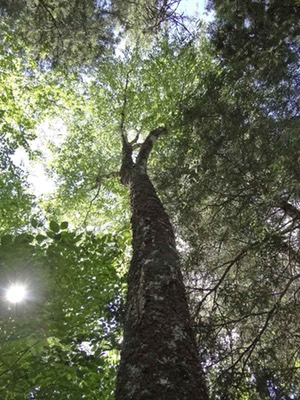 A week later (Friday Mar 2, 2018), DNR had checked out the precise site, and Bruce Stewart (NSDNR Manager of Forest Research and Planning) and Mark Pulsifer (a Wildlife Biologist and Regional Resource Manager, Eastern Division with NSDNR) were interviewed by Norma Lee MacLeod on CBC Information Morning about their findings and to comment on Danny George’s comments. The interview is available as an audio file, and I have posted an abbreviated transcript of the interview with Bruce Stewart and Mark Pulsifer.
A week later (Friday Mar 2, 2018), DNR had checked out the precise site, and Bruce Stewart (NSDNR Manager of Forest Research and Planning) and Mark Pulsifer (a Wildlife Biologist and Regional Resource Manager, Eastern Division with NSDNR) were interviewed by Norma Lee MacLeod on CBC Information Morning about their findings and to comment on Danny George’s comments. The interview is available as an audio file, and I have posted an abbreviated transcript of the interview with Bruce Stewart and Mark Pulsifer.
There is also a CBC text story by Phlis McGregor: Forester says old-growth trees cut on Crown land in violation of policy (CBC Mar 2, 2018) which provides a summary and highlights of the interview.
DNR on Old Growth and the Old Forest Policy
In the CBC Information Morning interview, a lot of the discussion revolved around whether the “Danny George Site” can be called Old Growth and if so, does that mean that DNR mis-identified the site?:
CBC’s Norma Lee McLeod: Bruce.. Daniel George says this is an Old Growth Forest. Is it?
BS: Our planning systems before we started assessing those stands didn’t indicate there was any old growth forest in that area.. after this story came to light, we sent our old forest specialist down to that area with the regional forester and there are certainly mature forests and large trees in that area, so we are going to go down, use our old forest scoring system which we use to evaluate the qualities of Old Growth forests and do an assessment of all of those stands and determine but at this point we don’t have any indication that is in fact old growth.
NLM: But you are not sure when that assessment will be done; if it turns it is an Old Growth forest, this shouldn’t have happened; how could it have happened?
BS: if [so]..we will be asking that question as well…at this point we don’t have any indication. We do have a very comprehensive old forest policy and conservation program…we do in that ecodistrict have almost twice as much Old Growth forest protected right now than the target…we have almost 27,000 ha protected. And we have some very good stands in the Loon Lake area that are protected in the Nature Reserve.
So at this point certainly there are mature forest trees that may contribute mature forest values but until we do that assessment we have no indication that those stands are old growth.
NLM: So It is possible that it could have been mis-categorized. If so, could there be more…is there a review if Old Growth forest that you should be doing – to ensure forestry is only happening where it is supposed to happen?
BS: Well, regarding Old Growth forest conservation we have been pursuing a policy to find the best Old Growth for the last 20 years, the regional foresters are assessing forests all of the time. They have pretty much completed the target levels in all ecodistricts. However, there is always the chance of finding a forest you didn’t expect to be there.
Our PTA process mandates that every site is visited on the ground before it starts… it’s a fairly new process. It has a flag in it that will identify any mature forest that has a potential to be old growth which would cause that stand to be assessed with the Old Growth scoring system before it’s treated.
NLM: So Mark, did that happen in this case?MP: We did not recognize any particular triggers that came with respect to the potential for old forest in there. We have a couple of different processes that we use, a desktop planning process that did not indicate any Old growth elements or characteristics there. We followed that up with some ground work through this pre-treatments process, and it did not pick up any thing either at this time.
Some comments on DNR’s perspectives
In the interview, Bruce Stewart elaborates on DNR’s Old Forest Policy and their system for scoring Old Forest stands… if a stand meets certain criteria (> 30 % crown closure, > 50 % of basal area in climax species typical of the landscape and > 30 % of the basal area > 125 years old), it rates an Old Growth status according to DNR’s scheme. The key factor: the average age of the smallest trees among the largest third of dominant trees. Basically, if that is 125 years, the stand is considered Old Growth; if its 124 years old it is not Old Growth. Other factors such as the amount of deadwood are scored but do not affect the final designation as Old Growth or not (and they do not look at other indicators of old growth such as the species of lichens). From Danny’s description of the stand, it sounds quite likely that it included trees >125 years old, but whether it ends up getting Old Growth status could depend on the vagaries of the sampling on that day.
I have been told by a naturalist who is familiar with stands in that area that they (the naturalist) would describe the area as Old Growth or containing Old Growth, but it’s not like there is uniform Old Growth everywhere; it is in patches, with patches of younger and earlier successional forest (e.g. with a lot of red maple) in-between as is typical of a lot of old hardwood and mixed forest in Nova Scotia subject to some wind disturbance.
There is a fairly high probability that even though such a forest could contain trees well over 125 years of age and has never been clearcut and perhaps only selectively cut in the past (if at all) and would be considered by most ecologists to be Old Growth that it would not qualify under the DNR sampling scheme. That scheme was developed totally in-house by DNR and reflects their own biases about disturbance regimes etc.
Addendum (Mar 6, 2018): Another factor that could lead to significant patches not being recognized, is that they are patches that were simply missed when harvesting was carried out years ago as Bob Bancroft discussed today on the Rick Howe Show; thus they could be retained in patches within a matrix of younger forest and be missed in both aerial surveys and in PTAs. Still one would think that should not constitute an excuse to harvest them once they are encountered – except that the Old Forest Policy has a clause (p6) that states: “Selections [of candidates for Old Growth status] must be large enough to be identified as a stand in the GIS”! In effect, unless you find an Old Growth stand that corresponds precisely to DNR’s definition of Old Growth over the whole area of DNR’s interpretation of a specific stand (given by a polygon) in that area from aerial photography, it won’t be accepted. There’s lots of wiggle room in the Old Forest Policy in favour of harvesting.
An independent investigation is called for
So given the controversy that has developed about this particular site, and also because it is on FSC certified land managed by PHP, an Independent Investigation of the site and its ecological significance is really called for, e.g. by MTRI.
I mention the FSC certification as a factor because the public expects something more out of FSC certification – that it guarantees genuine ecological sustainability – than simple adherence to the (controversial) NS Crown Land forest management requirements. The FSC status does require the holders to investigate any complaints… Is calling DNR in to address the complaints really sufficient in such a case? Perhaps it is only a stage in PHP’s investigation which we have yet to hear about publicly (re Post Mar 1, 2018).
Seeking shelter in Old Forest Policy
In some ways, Bruce Stewart seems to be saying that even if they do find that the “Danny George Stand” is Old Growth by DNR’s criteria, it wouldn’t be a serious omission if it is already cut as “we do in that ecodistrict have almost twice as much Old Growth forest protected right now than the target…and …the regional foresters are assessing forests all of the time..They have pretty much completed the target levels in all ecodistricts.”
It needs to be stated that NSDNR’s Old forest policy was developed entirely in-house and reflects their criteria for classifying forests as Old Growth, and also their criteria for what levels of Old Growth, or Old Growth + Old Growth Restoration Opportunities are adequate. I have talked to several Nova Scotia scientists with strong backgrounds in the ecological sciences who are not satisfied with either the classification or the target levels and the composition of many of the stands that are included. (We should but don’t hear at all from the more ecologically qualified scientists inside DNR or Nova Scotia Environment on such topics.)
For example, consider the target for conservation of Old Growth given in the Nova Scotia’s Old Forest Policy:
DNR staff will identify old growth and the best old forest restoration opportunities on at least eight percent of publicly owned forest land in each of the province’s 38 forested ecodistricts.
Eight percent of Crown Land is only 1/3*8=2.7% of our forested land, and most of what’s included now is in “restoration opportunities”, not in Old Growth*.
_______________________
*To see what’s included now go to the Old Forest Layer in the Nova Scotia Provincial Landscape Viewer. You could be shocked. I was. (I’m assuming this map layer needs to be updated which says something in itself.)
The focus is on “representation” rather than conservation and connectivity for which a considerably higher percentage would be required. They have included a lot of forest under their old forest policy/8% representation that already existed in Protected Areas, and especially in regard to the “restoration opportunities” was far from the best forest within the larger Crown area that could be selected…thereby taking off the pressure (or incentive) to find the better stands outside of Protected Areas.
DNR staff, as far as I am aware, has made no efforts to engage the public (certainly not Danny George!) in identification of additional suitable stands outside of Protected Areas.
“[We] have pretty much completed the target levels in all ecodistricts” says Stewart. OK, if you want to minimize the effect of an Old Forest Policy on the merchantable wood supply; it’s clearly not adequate to protect Old Forest/Old Growth as a significant component of the Nova Scotia landscape and to keep the best remaining Old Growth and Old Growth Restoration Opportunities that we have on Crown land outside of the protected areas.
There’s a lot more that could be said, and said by people more competent in this area than I. Some are not able to talk about it freely because they are dependent on NSDNR in one way or another. Like so much else, this facet of NSDNR Forestry Science needs to be critiqued by recognized, well published experts in the area, e.g. in the Bergeron group in Quebec that I recommended to the Independent Review.
More than that, NSDNR needs to come out of its bunker mentality and communicate freely and frequently with the larger scientific community and the public at large – the Crown land forests after all, belong to all of us. Hopefully we’ll see some changes following the Independent Review.
On possible mis-identification of stands
Norma Lee McLeod asked whether stands in the area could have been mis-categorized, and hence whether there “could be more Old Growth…is there a review of OG forest that you should be doing – to ensure forestry is only happening where it is supposed to happen?” The ensuing conversation continued on the topic of Old Growth conservation.
I suspect what NML was trying to cover in that part of the conversation was Danny George’s reference to “mis categorizing”, which was made in reference to the proportion of Intolerant and Tolerant species, not in regard to whether a stand might be classified as Old Growth or not. (NML can be forgiven for not being a professionally trained forester!). Said Danny George on InfoAM Feb 26, 2018:
What enabled this [inappropriate harvests] to take place from the beginning was the mis-typing of these forests in the provincial database. In the late 1970s and early 80s when these areas were first interpreted from aerial photographs they mis-categorized it; it was labeled 85% intolerant and it’s 85% tolerant hardwood…. Intolerant is basically a biomass product, largely red maple, white birch, that type of low end product.
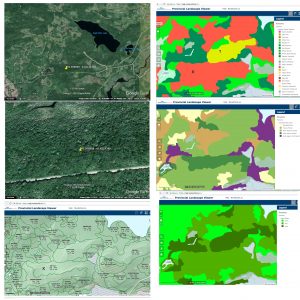
Google Earth images and layers from the Provincial Landscape Map Viewer for the “Danny George site” and nearby landscape.
Click on image to enlarge.
As far as I can see from the maps I am able to access, Danny could be right about this (view maps at right); the Danny George site is in a stand described on the Provincial Landscape Viewer as 70% Red Maple, 30% Yellow Birch. I am guessing that the prominence of red maple ruled it out right away from consideration of Old Growth status. Yet look the Google Earth image – there are some mighty big trees in there.
I wonder about the stand just to the northeast which is described as 60% yellow birch, 10% sugar maple, 30% red maple, and also appears to have some big trees on Google Earth. Also shown in that set of maps are the Developmental Class and Seral Stage layers – they are not consistent as far as I can see… all of which should have triggered a closer look by PHP and/or DNR (it’s hard to figure out who bears primary responsibility). What did the PTAs reveal? From Mark Pulsifer’s comment, that “Yellow birch is the target [of the harvest treatment]”, I am guessing that the PTA must have indicated a higher proportion of yellow birch than suggested by their desktop maps.
What about the purple areas in the Development Class layer…”Multi-aged/Old Forest”? Are they looking at those sites for possible Old Growth? Or are they just seen as high volume stands for harvesting?
There’s more… Old Growth by Rocky Lake
This story didn’t stop at “Danny George’s site” south west of Eight Mile Lake. On Saturday, March 3, this item by Aaron Berwick appeared in Chronicle Herald: DNR checking into allegations old growth trees cut (Subtitle: Department visits 1 in 10 sites before harvesting takes place*)
It’s accompanied by a photo for which the caption is “Former sawmill owner Scott Cook stands in a hardwood stand recently cut by Port Hawkesbury Paper that he and a local harvester [Danny George] say was old growth”.
_________
*This seems to contradict the statement of Bruce Stewart in the InfoAM Interview: “Our PTA process mandates that every site is visited on the ground before it starts… it’s a fairly new process. It has a flag in it that will identify any mature forest that has a potential to be old growth which would cause that stand to be assessed with the Old Growth scoring system before it’s treated.”
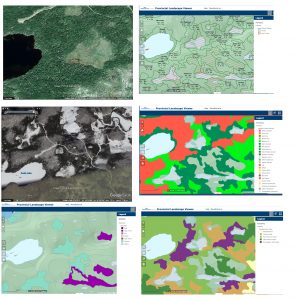
Google Earth Map and Provincial Landscape Map Viewer layers showing lands just east of Rocky Lake.
This article refers to forest in the area of Lawlor Lake and Rocky Lake which are north of “Danny George’s site”, and are likewise not shown on the Harvest Plan Map Viewer.
According to Port Hawkesbury Paper, it has cut 81 hectares of hardwood over recent months in the area and has 40 hectares left to cut.
“The area just east of Rocky Lake is about 40 acres and it’s old growth,” said George, who works as a selective harvester of hardwood off private lands.
“It would be one of the best examples of old growth you’ve seen.”
Cutting has ceased in the area for a month or more as warmer temperatures have made the roads too soft.
– From DNR checking into allegations old growth trees cut, Chronicle Herald, March 3, 2018.
Looking at a set of maps for this area, it looks like a repeat of the story above…
———–
Thanks to Danny George for his persistence and straight talk, Thanks Scott Cook for speaking up and Kudos to Aaron Berwick/the Chronicle Herald and CBC/Phlis McGregor for doing some digging on this story.
As always, I stand to be corrected and, after a lengthy blast at NSDNR, the postscript of Aug 22, 2016 on my About this site page bears repeating:
Postscript
I am pretty critical of the Nova Scotia Department of Natural Resources (NSDNR) in these pages, however it is not universal and it is definitely not personal. There is a lot of good work done by this department, and I make a lot of use of resources provided by NSDNR.
My concerns relate overall to (i) the decisions that continue to support a form of industrial forestry that is highly destructive of forest and aquatic biodiversity in Nova Scotia, exploits small woodlot owners, and provides fewer and fewer benefits to the people of Nova Scotia at large; (ii) the science purported to support these decisions or at least the public presentation of the science; and (iii) the veil of secrecy or control of release of pertinent statistics compiled by NSDNR.
I am not the first, by a long shot, to express such concerns either within or outside of government. I do hope these pages will contribute constructively, however incrementally, to debates about such issues and, I would like to think, their resolution.

